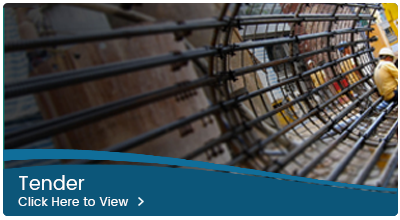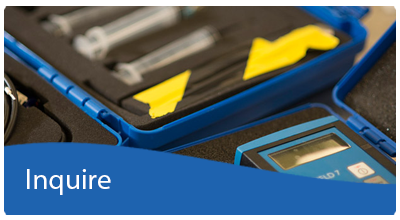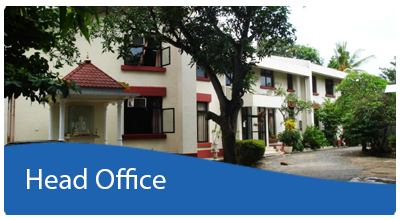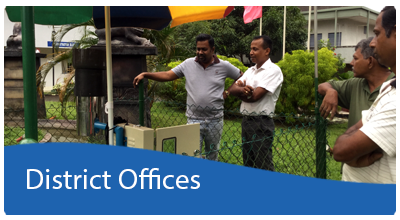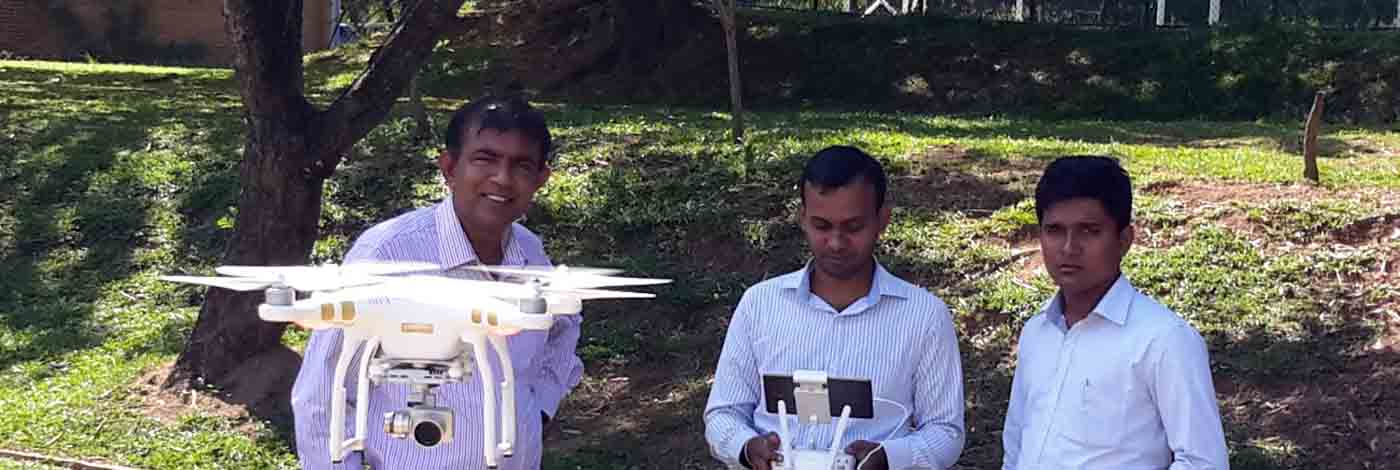The primary focus of the 2018 R & D programme of NBRO was set on building disaster resilience in the country. Outcomes R & D programme was presented and published at the 9th Annual Research Symposium of NBRO ‘Innovation for Build Back Better’ held on 18thand 19th of December 2018 in Colombo. Altogether 38 technical papers were published in the Symposium Proceedings.
Under the past years research and development programme, NBRO researchers were given the opportunity to propose their research areas and conducted studies with expertise knowledge through various collaborations. Some of the conducted research studies with the external collaborations were;
- Determination of regional and local rainfall thresholds for landslides in Sri Lanka.
- Developing a comprehensive model to compute root-based suction and the root reinforcement effect for mechanical strengthening of sub-soil formations and improving the hydrological regime of the slope.
- Designing a transitional shelter for disaster affected communities.
- Development of cost-effective green masonry products using textile waste and coal-fired boiler ash.
- Development of alternative fibers to asbestos fibers for roofing.
- Development of guideline for selection of materials and products for construction industry.
- Development of geotechnical guidelines for high-rise buildings.
- Analyze the effect of meteorological, environmental and anthropogenic factors attributed to drought severity and sector-based water stress in Anuradhapura District.
- Preparation of Technical Guidelines for Building Demolition work in Sri Lanka.
In 2019, NBRO has been allocated funds to continue its research and development programme. Keeping with the tradition, NBRO conducted an industry consultation programme in the beginning of 2019 to consult its stakeholders to learn about the industrial perspective towards current and future research. Having learned their research requirements, NBRO expects holding discussions with them while formulating future research studies.
It is expected that internal research groups will be formed to cover each of the selected research areas and NBRO will conduct these research studies with external collaborations to solve the industry issues for the nation. With the experience of past research and development programmes, NBRO is planning to conduct 2019 programme in a more effective manner.
An Industrial Consultation Programme was conducted on 27th February 2018 at the Renuka Hotel, Colomboin order to identify research requirements of stakeholders. Subsequently, the following research proposals from NBRO Scientists were received for the Research and Development Programme – 2018:
- Development of geotechnical guidelines for high-rise buildings (GED)
- Formulation of rainfall threshold values for landslide hazard based on regional parameters (LRRMD)
- Design of a model Transitional shelter for disaster-affected communities (HSPTD)
- The effect of meteorological, environmental and anthropogenic factors attributed to drought severity and sector-based water stress in Anuradhapura District (ESSD)
- Developing a comprehensive model to compute root-based suction and the root reinforcement effect for mechanical strengthening of sub-soil formations and improving the hydrological regime of the slope (LRRMD)
Additionally, the following research studies from last year will be extended to 2018:
- Development of cost effective green masonry products using waste materials from textile industry (BMRTD)
- Development of natural fiber cement composite for building materials (BMRTD)
Research Studies continuing from previous year
- Determination of the Effect Anthropogenic Pressure on the Watershed Health, Stream Ecology and Quality of Water Resources of Pinga Oya sub-watershed in Polgolla Watershed
- Systematic Diagnostic Assessment of Industrial and Facility Related Chemical Disaster Risks in Sri Lanka
- Settlement of shallow foundation on residual soils in Sri Lanka
- Monitoring the effect of rainfall in the pore pressure regime of a slope and effectiveness of vegetation in enhancement of stability
- Thermal and environmental performance of a pre-cast building system
- Flood risk assessment in Ratnapura Municipal Council Area
- Development of alternative and sustainable materials for construction of gravity/ semi-gravity retaining walls
- Evaluating the hazard situation caused by karst subsurface conditions at Vijaya Sirigama Village, Digana, Kandy
- Use of soil nailing cost effectively in improvement of slope stability in Sri Lanka
- Performance study of concrete strengthening techniques in Sri Lankan context
New Research Studies
- Developing a systemic approach of investigation for old public buildings and apartments (rental houses) in Colombo District
- Investigating the suitability of using polyester spandex offcuts for roofing sheets/ Development of alternative fibers to asbestos fiber for roofing materials
- Utilization of waste sludge produced from aluminium extrusion industry as a partial replacement material for clay in clay bricks.
- Development of cost effective green masonry products waste materials
- Management of indoor environmental quality in office buildings by using machanical methods and phytoremediation plants
- Establishment of Spatial Database of Element at Risk
- Study on the Land Use changes due to anthropogenic activities and its impact on landslide occurrence in Sri Lanka
- Evaluation of post-disaster housing reconstruction; Case study on Resettlement of Meeriyabedda Landslide victims in Makaldeniya Estate
- A characterization of the physical properties of soil and their implications for landslide occurrences on mid of May 2016 in Kagalle district.
- Pore water pressure factor how to affect Aranayake landslide
- Confederation of real landlside conditions into map interpreting ground/ slope failure along the A category road side in Kegalle district.
- Assessment of identified landslide hazard area and creating a database: A case study in Kegalle district
- Accuracy assessment of the existing landslide hazard zonation map using Lidar data
- Importance of subsurface investigation for landslide mitigation - A case study from Dharmavijaya Pirivena, Kalutara
- Analysis of road cut failures and designing of countermeasures - A case study from Bulathsinhala, Horana road, Kalutara
- Geological and geotechnical characterization of landslide for mitigation purpose - A case study from Meegahathanne District Hospital, Kalutara
- Study on the Crack Formation Causes in buildings within Weragama GN, Minipe, Kandy
- Landslide Analysis - Case Study Ilikwatte
- Origin and characteristics features of colluvial fan and sedimentary gravity flow by tracking landslide chronology and granulomrtic analysis. A case study from Garadiella
- Applicability of existing landslide hazard zonation model and proposing relevant factors based on contemporary data: A case study of Udathalawitiya landslide in Rathnapura district
- Development of expert system for seismic vulnerability assessment of existing masonry buildings in Sri Lanka
NBRO received a research grant in 2016 to continue its research and development programme. Research proposals from NBRO scientists for 2016 comprise of many new proposals and several proposals to continue the research work of previous years.
New research studies are comprised;
- Determination of the best mix for Bottom Ash Blocks and field conducting trials/ testing on a model house.
- Development of alternative roofing material to substitute asbestos-cement roofing material and for use in disaster resilient housing.
- Development of alternative and sustainable materials for construction of gravity semi-gravity and cantilever retaining walls.
- Evaluating the hazard situation caused by the Karst subsurface conditions at VijayaSrigama village, Digana, Kandy.
- Determine the effect anthropogenic pressure and the watershed resilience on stream water ecology and water quality.
- Systematic diagnostic assessment of select chemical disasters in Sri Lanka.
- Long term Sustainability of Post Disaster Housing Reconstruction Projects.
- Flood Risk Assessment in Rathnapura Municipal Council Area.
- Evaluation of presently applied designed criteria and mitigation measures for Sri Lankan landslides and selection of most suitable design by modelling.
- Applicability of Relative Weights of Existing Landslide Hazard Zonation Methodology for Different Terrain Conditions of Sri Lanka.
- Setting of Standard Rainfall for Early Warning System (EWS) considering past landslide incidences in Sri Lanka with reference to 24hrs working rainfall.
- Contribution of Geological Structural Orientation on Cut Slope Failures along Roads in Mountainous Terrain.
- Finding the cause of land subsidence in limestone terrain of Achchuwlei area, Jaffna.
- Performance Study of Concrete Strengthening Techniques in Sri Lankan Context.
- Behavior and Pattern of Description in Relation with Different Rock Types and its Application for Design of Sub ground Construction.
- Modes of occurrence and geotechnical behavior of laterite in low land area.
- Early warning system for landslides with threshold limits by using remote sensors: A case study of Badulusirigama landslide in Sri Lanka.
- Settlement of Shallow foundation on soils in Sri Lanka.
- Use of soil nailing cost effectively in improvement of slope stability in Sri Lanka.
These proposals were presented to the Research Committee at the meeting held on 3rd March 2016. As per the advice of the Research Committee, initial literature surveys of these studies have commenced.





